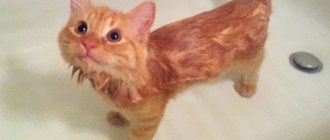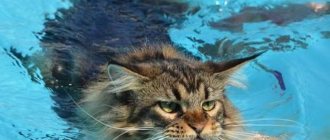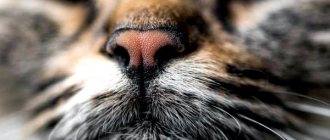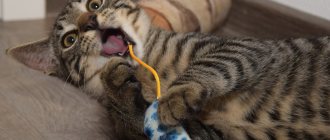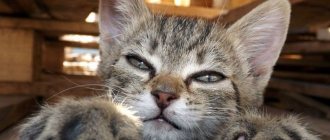It is believed that cats hate water, and it is believed that this is because they cannot swim. In accordance with their natural instinct, they avoid water so as not to accidentally drown, so they say. However, many owners have cats that love to play in bathtubs and pools. Large cat breeds such as jaguars and tigers are often seen swimming well and at great speed. This may make you wonder if your indoor cat will be able to swim to safety if it falls into the pool.
Cats can swim in water. This is a natural instinct that all cats have, and most of them automatically start paddling when they are underwater. Young kittens may be less agile than older cats and have difficulty swimming. However, they still have an instinct, and with age they will become more skilled at swimming. However, many domestic cats avoid water because it weighs down their fur and creates discomfort.
Some breeds of domestic cats don't mind this and are excellent swimmers. These include the Maine Coon, Bengal, Turkish Van, Savannah, Manx, Norwegian Forest Cat, Abyssinian and Japanese Bobtail. This may vary depending on the individual cat and her past traumatic experiences with water. Despite this, it is quite possible to teach a cat to swim.
Main reasons for fear
The fear of water has been instinctively ingrained in cats since ancient times.
Even the ancestors of representatives of the cat family had no need to contact the aquatic environment to obtain food, hunt mice and rodents, and getting wet caused only one problem: Impaired heat exchange. When a cat's fur gets wet, it loses its insulating function, causing the animal to become very cold.
Infections. Dirt actively adheres to wet fur, which leads to the accumulation of bacteria and other pathogens, and this is extremely dangerous for the cat’s health.
Smell. The wet fur begins to smell quite strongly. This specific aroma interferes with hunting, scaring away potential prey, and also attracts dangerous predators.
Overheat. During the hot season, the wool layer performs a protective function, protecting the cat’s delicate skin from exposure to aggressive ultraviolet rays. When the coat gets wet, the protective function is lost, and the animal can suffer seriously from overheating.
Wash off protective lubricant. Cat fur is coated with a special protective lubricant, invisible to the naked eye, which gives it shine and luster and protects it from breakage and loss. Frequent contact with water leads to degreasing of the animal's fur and skin and worsens its condition.
Drying time. After bathing, as the results of numerous studies and experiments have shown, a cat needs at least several hours to get its fur in order.
Chlorinated water. Animals have an extremely negative attitude towards the smell of chlorine, which is characteristic of tap water. This problem can be solved by using pre-boiled and settled water for bathing.
Misbehavior of the owner. Often, due to the careless actions of the owners during the bathing process, water gets into the pet’s ears, which can lead to serious consequences, including inflammatory processes and deterioration of hearing function.
Therefore, it is necessary to exercise great caution when bathing your pet, and even better, place protective cotton swabs in the ear canals of the purr in advance and avoid getting copious amounts of liquid on the cat’s head.
However, some cats happily splash in the water without experiencing any fear.
Manx
The most famous tailless cat completes our list of water lovers. According to legend, she lost her tail while jumping onto Noah's Ark at the last moment - her luxurious long tail was simply cut off by the closing door.
Not all Manx cats like to swim, but the sight of a stream of water seems to hypnotize them all without exception. They can sit for a long time and watch the flow of water from a tap or the operation of a toilet flush and often even understand what to do to achieve what they want. This is a very affectionate and friendly breed.
As always, we ask you to remember that each cat is unique and belonging to a breed does not guarantee a match with all the characteristics. In the end, regardless of love or dislike for water, attitude towards people and animals and other features, it is very difficult not to fall in love with these charming purring creatures.
Fear of hypothermia in cats in water
A cat has a so-called “air cushion”, it is located between the fur and the skin. This pillow prevents the cat from freezing. When wool gets wet, the thermal insulation is compromised. But a dog is not afraid of water, why is a cat so shy of the water element? To understand, let's remember the behavior of dogs and cats.
So, let's look at the behavior of these two animals. As we all know, a dog is a herd animal, a cat, on the contrary, is a solitary animal. From here it follows that the Bug got wet, snuggled up to the nearest Bobik and warmed up. She ran out to hunt, got wet, and by the time she ran after the game she was already dry. And the most important trump card is that they know how to shake off water. Now it’s clear why cats have such a wild reluctance to bathe: there’s no one to cuddle up to, they don’t chase prey, they stalk them, waiting in ambush for the right moment, they can’t shake themselves off. It got wet and everything will lie there until it freezes, but the dog ran around, played and is dry. Of course, this does not threaten domestic cats, but no one has canceled genetic memory.
The smell is to blame
The cat does not chase prey, but sits in ambush. But all may be in vain if the potential prey catches the scent of a predator. Wet wool emits a strong odor that is not difficult to notice. Getting wet means being left without lunch.
God bless him with dinner, he wouldn’t be able to get into someone else’s meal! Wet fur not only interferes with hunting, but also attracts a larger predator. Bobik will be warned by the nearest Tuzik, but the cat has to rely only on himself.
Hygiene comes first
Wet wool quickly becomes dirty with dirt and dust, which later end up in the stomach when licked. Along with all this, all kinds of bacteria, microorganisms, and fungi enter the stomach.
Turkish van
It seems that this indigenous breed of semi-longhaired cats has no idea that it should be afraid of water. For centuries she lived near the island of Van in Turkey, where she fished and swam just for fun. Due to the absence of undercoat, wet wool dried very quickly and did not cause discomfort.
The Turkish Van loves to play with trickles of water in the sink and splash around in the filling bathtub. He becomes very attached to one owner, although he usually gets along well with the rest of the family. Very talkative and emotional, loves to be the center of attention and sit in arms.
Truth or Myth
Of course, this is actually just a legend. In fact, felines are excellent swimmers. This applies to tigers, panthers, pumas and many others. Why should the domestic cat be an exception?
Another question is that the vast majority of cats simply do not like to swim, or rather, to get their skin wet. We'll talk about the reasons for this a little later. All mammals, without exception, can swim. Cruel and rational evolution has long since eliminated all those not endowed with this skill. After all, there are quite a lot of critical situations when cats rush into the water without hesitation.
:
- The need to escape in a flood.
- Everyday hunting.
- Fleeing from a more dangerous enemy.
This is not a complete list of reasons for cats to plunge into water, including ice water. True, modern pets simply do not find themselves in such situations. They are not threatened by flooding, food is obtained in a bowl, and they usually do not encounter predators that pose a threat.
Waterfowl
Strange but true: many wild cats have no fear of hypothermia, overheating or germs. They are not even afraid of the smell, which makes the cat more noticeable to prey and potential enemies. Wild cats that love to swim happily frolic in the water, dive and catch splashes, absolutely not thinking about the consequences of getting their fur wet: tigers, servals, jaguarundi, Sumatran cats.
The lifestyle of the speckled cat is remarkable. Viverrina would probably be very surprised to learn that some people doubt whether cats can swim. This savage does not miss a single chance to splash around, diving deeply and swimming several meters underwater. In addition, she hunts fish, preferring river inhabitants to land-based prey.
How to train your pet not to be afraid of bathing
You need to get used to the process of bathing gradually. You should not bathe a kitten until 4 months of age - this can lead to severe hypothermia and a decrease in immunity.
Do cats need to be washed at all?
We must remember that the wild brothers and ancestors of modern domestic purrs were inhabitants of dry steppes who ate fresh prey and did not need additional drink. In addition, whiskers are very clean creatures that do an excellent job of tidying themselves up with the help of their tongue. By licking themselves, they break down contaminants with their bactericidal saliva and easily get rid of them.
A pet rarely needs to be washed by a person. Moreover, some veterinarians are against this procedure, because it is fraught with complications and is almost always accompanied by negative emotions.
You should not bathe your pet more than once a quarter, but it is better to carry out the procedure 2-3 times a year. The only exception may be an allergic reaction to the fur of a furry friend on the part of the owner and family members. Other reasons to wash your pet:
- the cat is not very clean;
- Dirt cannot be removed by regular licking;
- the wool gives off an unpleasant odor;
- ectoparasites (fleas, lice eaters, etc.) appeared on the body.
The need to use detergents is also associated with the prevention of skin diseases. In addition, if a handsome man with a mustache participates in exhibitions or championships, then he will have to be tidied up before each public appearance.
6 stages of training
A furry dog of any age will react negatively to the owner’s attempts to put him in the bath. Therefore, so that the cat is not afraid of water, it must be gradually accustomed to washing.
It’s good to start by introducing the mustache to the environment in the room. The animal must sniff everything, get used to unknown sounds and smells.
Experienced owners advise putting the animal in a dry bath and putting his favorite toys in there. Over time, the animal will stop panicking and running away. Then you can begin the first bath procedure. It occurs in several stages:
- Pour a few centimeters of water into a bathtub or basin and place a towel or mat there to prevent the mustache from slipping.
- Slowly lower the animal into the container.
- Wet your pet's fur. If he is calm, then you can turn on the shower.
- Lather your body with shampoo and massage thoroughly. Do not allow foam to get into your pet's ears, nose or mouth.
- Rinse off the shampoo and remove the cat from the container.
- Dry the wool with a towel and then wrap it in a dry sheet or other towel.
After bathing, it is not recommended to dry the animal's fur with a hairdryer. This can be scary and uncomfortable. The first wash should not last long. In the future, the duration of the procedure is determined individually.
Alternative to washing
If your pet's fur is not dirty, then you shouldn't bathe it. For individuals with short hairs, it is best to simply comb them periodically. Long-haired representatives are combed regularly, and during the molting period they do this 3 times a week.
A wet towel, which is used to wipe the soiled part of the body, will help get rid of light stains. Some owners of animals participating in exhibitions and championships use dry shampoos. These products clean the coat well, and do not need to get it wet.
Conclusion
The fear of domestic purrs of water and the manipulations carried out in it can be explained. Cats are afraid of water literally at the level of instincts. They don't want to be noticed, freeze or overheat, go deaf or catch a bad cold.
Inexperienced owners try to break their pet's reluctance by force, forcing him to endure unpleasant moments. The best way is to gradually accustom the animal to the bath, without coercion or punishment. Only in this case will the pet mustache positively perceive bath procedures.
The article is a recommendation!
Reproduction [edit | edit code ]
The duration and timing of the breeding season of hares varies depending on the part of the range. Thus, in Western Europe it usually lasts from March to September; During this time, about 75% of females manage to bring 4 broods, and in years with warm winters and early spring - 5. In favorable climatic conditions, the rut continues all year, and the first hares appear in January. In the north of the range there are 1-2 broods. In central Russia, the first rut takes place at the end of February - March (males are active from January), the second - in April - early May, the third - in June. Pregnancy lasts 45-48 days, so the first hares appear in April - early May, the second brood - at the end of May - June (peak breeding), the third - in August. Hares mate again immediately after giving birth, and sometimes before them. In general, the rutting season of hare is not as smooth as that of white hare, so pregnant females and hares can be found earlier and later than normal seasons.
The number of hares in a brood ranges from 1 to 9. The size of the brood is influenced by many conditions. In general, litters are larger in areas where hares have fewer reproductive cycles. Winter, early spring and autumn broods are smaller than summer ones - they contain 1-2 hares. Middle-aged females bear the most litter. Before giving birth, females make primitive nests of grass, dig holes or, in hot climates, shallow burrows. The young hares are born sighted and covered with fur, weighing 80-150 g. The female comes to feed the offspring once a day, and sometimes less often - up to once every 4 days. From the 5th day of life, the hares begin to move near the place of birth; by 2 weeks they reach a weight of 300-400 g and are already actively eating grass, and at 3-4 weeks they become independent. There are known cases of female hares feeding other people's hares, provided that they are the same age as her own, but this is observed less frequently than with hare. Brown hares usually reach sexual maturity only the following spring; very rarely, in the western parts of the range, females begin breeding in the same summer. There are known hybrids of hare and white hare - cuffs. They were found both in nature and obtained from keeping hares in the zoo. When kept in captivity, cuffs are capable of reproducing.
The lifespan of hare is 6-7 years (in exceptional cases they lived up to 10-12 years), but most of the animals live no more than 4-5 years.
Cat breeds that are loyal to water
Yes, the relationship with water in domestic cats depends on how the first bathing experience goes, as well as on the character of the pet itself. The more curious and fearless the kitten, the more likely he is to enjoy the water element. Conventionally, we can distinguish the following breeds, whose representatives are more loyal to water procedures than others.
Table 1. Cat breeds that love water
Breed Characteristics
Sphinx
These hairless cats occupy the first place in the ranking of cat breeds that show an interest in water. This may be due to the lack of hair and the fact that Sphynx cats dry very quickly after bathing, and therefore do not experience discomfort. The only thing the owner needs to monitor is the temperature of the water so that the hot cat does not catch a cold or get sick.
Kurilian Bobtail
Bobtails have a high level of intelligence and are also very attached to their owner, so they follow him even to the bathroom. If the cat considers that the water does not pose a danger to it, it will be happy to accompany the owner during water procedures.
Abyssinian cat
Active and funny Abyssins, for the most part, are not at all afraid of getting wet. These are very mischievous cats, ready for energetic and active games in any form, so a representative of the Abyssinian breed will not be embarrassed by water splashes, which are so exciting to catch.
Maine Coon
Large and brave, these cats often accompanied sailors in the past, and nowadays they are loyal to the water. It’s not for nothing that Maine Coons are called “dog-cats,” and when it comes to bathing, representatives of this breed are more like dogs who love to frolic in the water
But, if a Maine Coon is afraid of water procedures, he will resist like a wild animal, so it is important to accustom the kitten to bathing as early as possible.
Devon Rex
Gentle and good-natured Devons, like sphinxes, have a very modest fur coat and dry quickly after water treatments. In addition, these cats are playful and good-natured, so it is enough to invite the Devon Rex to play in the bath for the pet to become interested in new entertainment.
Savannah
Energetic savannahs were bred by crossing domestic cats with wild ones, perhaps it was from such inbreeding that they developed a love for water
Many savannah owners note that these cats are not at all afraid of moisture, but on the contrary, they look for every opportunity to frolic in the water or play with water splashes. Savannahs kept in country houses sometimes even voluntarily swim in pools or outdoor fountains.
Bengal cat
By nature, Bengals are similar to Savannahs, and they have the same love for water. Spotted beauties happily cool off in the sink on a hot day, often ignore a bowl of water, preferring to drink running water from the tap, and also play in a filled bathtub or even basin.
Norwegian Forest Cat
These strong, large cats are not afraid of water, like their wild relatives. The stern Norwegian is quite ready to walk in the rain or heavy snow, and will also swim in a filled bathtub and even “hunt” for toys if the owner offers him such entertainment.
Turkish van
According to legend, a representative of this breed left Noah's Ark to swim to the Turkish shores. But the country greeted the cat with such unbearable heat that she plunged into the cold Lake Van, from where she got her name. Modern representatives of the breed fully correspond to the legend, and are extremely loyal to water in all its forms.
Egyptian Mau
These are cats with a very flexible nervous system, adaptable and curious, and this also applies to water procedures. The Egyptian Mau enjoys taking baths, playing with water streams and splashes, and even swims in artificial reservoirs without problems, if it has access to them.
Siamese cat
Independent Siamese cats are also lovers of water treatments. Owners note that cats jump into the bathtub or walk into the shower without fear, try to catch toys in the silt of a filled bucket, and do not run away from the irrigation system in the garden.
Most often, sphinxes like to bathe and even play in the bathtub
Mr. Cat Recommends: Legends of Cat Hydrophobia
In fact, cats are not afraid of water at all and even kittens can swim. Most people don’t want it, they don’t like it. And they have reasons for that. Even a couple of legends about Noah's Ark try to explain this fear and hostility.
According to the first version of the story about “every creature in pair,” Noah announced to all the animals gathered on the ark that during the long voyage there should be no quarrels or attacks on each other. But then the Devil himself came into play and, turning into a huge rat, began to gnaw a hole in the hold.
The cat, noticing that the ship was in danger of sinking, caught the rat and strangled it. And the angry Noah ordered to throw the animal into the water as a violator of peaceful neutrality. Later, the savior of mankind was told how the events actually happened and the wet, poor fellow floating behind the ark was returned on board. But all cat descendants have a dislike for water.
According to another legend, there could not have been a cat on Noah’s Ark, since this species had not yet appeared on earth. But the rats began to overcome all the participants in the rescue expedition during the swim. And then Noah ordered Leo to destroy all rodents. The king of beasts did not consider it possible for himself to chase small nimble creatures. He sneezed and created a cat. It was she who destroyed all the pests, but since then she has had a dislike for water and has been wary.
But if you don’t mention myths, cats’ dislike for water is quite explainable at the level of genetic memory. After all, their ancestors appeared in hot, dry steppes and deserts and simply did not know rivers, lakes and seas. Therefore, they have no desire for voluntary swimming. On the contrary, those cat species that historically grew up near water are excellent swimmers and fishermen.
This is interesting: Calming drug Fitex and its use in cats
Why cats don't like to deal with water
Surely you will be interested to know that there are cats in the world that quite successfully bathe, swim and even fish in bodies of water. And a species like Vivverina can even dive to depths, and such individuals have membranes between their toes.
But “our” cats, that is, those who live next to us, are deprived of these abilities. But it cannot be said that they are afraid of water. In fact, cats are quite fearless creatures. They are not fearful, but rather reasonable, which allows them to avoid many dangers. What we mistake for fear is ordinary dislike. Mustached pets simply do not like to resort to water procedures, and there are quite logical explanations for this.
What do hares eat?
The diet of animals is based on plant foods in the form of bark, young shoots, grass, berries, vegetables and fruits. Hares living in temperate latitudes prefer clover, dandelions, sedge, yarrow and alfalfa. In the summer, there is always enough food for them, since they can easily taste blueberry shoots and berries, mushrooms, as well as the fruits of wild apple and pear trees.
With the onset of cold weather, hares have to switch to pasture, so they begin to feed on tree bark, as well as annual shoots. In the harshest winter periods, hares pull out various roots and dried grass from under the snow.
Possible hypothermia and fear of being overheated
Cat fur has a specific structure. The fur provides her with impeccable protection. A pet's fur coat plays the role of thermal insulation, due to the fact that air is retained with the help of fur hairs and a protective layer is formed.
Water that gets on a cat's fur displaces the air membrane, and the fur loses its ability to insulate heat. A wet cat quickly freezes and cannot warm itself until it dries. A cat that gets into water can get sick.
That is, the cat is not afraid of water, it avoids the possible negative consequences that await it as a result of getting wet. They cannot shake water off their fur and it is very unpleasant for them to get wet.
In hot weather, cats also do not want to bathe, and the reason again has to do with insulation. Losing this ability, wool cannot protect the animal from heat and sunlight.
Cold and hot shower
When you take your pet in your arms, you always feel the warmth emanating from him. This is due to the fact that cats have a higher temperature than ours, and, therefore, the temperature of the water when bathing the animal must be made hotter than we are used to doing for ourselves. For a pet, this means washing in ice water. How many people do you know who will be grateful to you for a forced ice shower and will stand silently, not trying to escape? The skin receptors in a cat, like any other warm-blooded creature, perceive this as violence. And if they beat you, you have to run.
Cats don't really like the smell of perfume, especially if they start rubbing it into their fur. For small predators, such a fragrance is similar to the smell of fertilizers for us. Imagine if you started lathering your lady with something similar. It is unlikely that you would get away with scratches and a dissatisfied look.
Why are cats afraid of water?
In fact, cats are excellent swimmers and, as you know, those who can swim well simply cannot be afraid of water. Therefore, to the question of why cats are afraid of water, we can safely answer that they are not afraid of this life-giving substance, but of the negative emotions associated with immersion in it. Let's take a closer look at why the water didn't please the meowing pet.
Fear of getting the fur wet
Water and cats are incompatible for the simple reason that the animal’s coat has a unique and peculiar structure. Cat fur has a layer of air, which gives it high thermal insulation properties. This is what allows the animal not to freeze in the cold and feel comfortable in the hot season. If water gets on the fur, it simply destroys this protective barrier, and the cat freezes, and it cannot warm up for long enough. Having experienced such “extreme” sensations for her at least once, following the natural instinct of self-preservation, she is unlikely to be happy with subsequent water procedures.
Bathing is a useless procedure
Yes, this is exactly what your pet thinks when you once again try to bathe him. Moreover, if this is done without the “consent” of the animal, and even with all sorts of cosmetics. They may be pleasant to the human sense of smell, but cats simply cannot stand them. So it turns out that your seemingly understandable efforts and aspirations are simply not pleasing to her.
Unpleasant smell
A cat is a hunter who does not chase, but lies in wait for its prey. And bathing helps its skin become warmer and begins to emit a strong odor that prey can smell. And what hunter would allow himself to be discovered, and even through no fault of his own? And a cat simply doesn’t know how to shake off like a dog. Therefore, it will take much longer to dry and freeze.
How often can you bathe a cat?
You still need to bathe the purring miracle, but not often. It is recommended to do this when soiled, when the animal clearly cannot cope with its toilet on its own. Bathing is necessary in the following cases:
- preparation for participation in the exhibition;
- prevention of tangles;
- assistance in the fight against parasites;
- soaking off stuck dirt and other heavy contaminants.
There is no need to overuse frequent bathing. This is fraught with a decrease in the natural layer of fat on the animal’s skin, which protects the cat from dirt and dampness. In principle, if the animal is healthy, then it can keep itself clean on its own, and caring for the cat, such as washing, is a whim of the owner.
What can replace the hated bathing?
Modern means and devices for caring for pets make it possible to protect them from such unpleasant contacts with water. It is enough to purchase a metal comb with sparse teeth for thick and long hair and a “tool” with more frequent teeth, which will help effectively deal with tangles. It is also useful to stock up on dry shampoos and disinfectants, all of which should be fragrance-free.
Can cats swim?
This question worries the minds of many people, and children in particular. Cats, like almost any animal, not only know how to swim, but also do it very well, especially in extreme situations. They do not have their own personal swimming style, so they “borrowed” it from dogs. It may be hard to believe, but there are purrs who not only love, but simply adore bathing! Most likely, this is the merit of the owners, who were not lazy and were able to properly organize the process of getting the pet accustomed to water procedures.
In fact, the decision about whether to bathe cats is made by the owner himself, depending on personal preferences, beliefs and observations of his pet. In any case, it is necessary to take into account the nature of the animal and respect its fears. For this, the cat will respond to you with affection, love and obedience.
Human-induced contact
The procedure of bathing a cat deserves a separate discussion, it is difficult for both the animal and the person. Why are cats afraid of warm, pleasant water, after which they turn from hopeless dirty creatures into neat, cute pets with silky fur? Here you need to take into account the fact that a cat is a freedom-loving animal that does not tolerate anything imposed. She even goes into arms only when she wants it.
And here, not only was the animal grabbed against its will and began to squeeze (showing tenderness is a standard preparation for bathing), but a tub of water was also poured on its head.
What people consider pleasant and comfortable (warm water, fragrant shampoo), cats consider unpleasant and useless (and why use a tongue that can perfectly lick yourself?).
In addition to water itself, cats may not like scented washing products: they are disgusted by the smell of even not very scented soap; ordinary shampoos used by owners can cause an allergy in the cat, manifested in dryness, peeling and redness of the skin (symptoms are not visible under the fur, but they are very annoying for the pet), as well as sticking and dulling of the fur.
When asked why cats are afraid of water, Wikipedia gives the answer that moisture negatively affects the air cushion located in the cat’s undercoat area - it literally washes it away. And until the animal dries out after water treatments, it feels very uncomfortable - after bathing, the cat’s body temperature drops by 5-7 °C, and the animal constantly trembles even under a towel.
Home Fears
Even the most affectionate cat can instantly become a wild beast if you offend it. She will not hesitate to use her teeth and claws, fighting for the right to remain dry as fiercely as if there were boiling water in the bath. But if you look into why cats don’t like to bathe so much, aggressive behavior will be justified:
- Forcing people to use water procedures is a major mistake. This is not a dog under a leader. Even a hint of force makes the cat instinctively resist. And the more stubbornly the owner stands his ground, the fiercer the fight for freedom.
- The slippery surface of the bath frightens a pet who is accustomed to trusting its tenacious claws. The ground knocked out from under his feet makes him defenseless. There is only one way out - to run at full speed, no matter the cost.
- The sound of water resembles a stormy current or a waterfall. To get there means to die, and the voice of the ancestors sounds the alarm. In such a situation, the cat is not just afraid of water, he is in a real adrenaline panic.
- The stench of household chemicals, air freshener and shampoo causes disgust and a desire to run away immediately. The sense of smell of cats is several times stronger than that of humans - the aromas of fragrances that are pleasant to people torment their sensitive sense of smell.
- When swimming, water floods the ears, nose and eyes. Cats avoid getting their hair wet because they need a keen sense of smell, hearing and vision to survive. And in such conditions you get the feeling that you are about to drown. Well, the instinct of self-preservation will make even a gentle murka attack its owner.
Turkish Angora
Another guest from Turkey at first glance seems fragile, tender and almost defenseless. No way! She is strong, playful, agile and very active.
Like the van, the angora does not tolerate the absence of affection and loves to remind itself of itself with a loud but melodious meow. Most cats love water treatments and can climb into their owner’s shower to bask under the streams of water and at the same time remind them of their existence. This is also one of the most intelligent and inquisitive breeds, easily opening bags and cabinets and loving to explore every centimeter of the apartment.
Causes
Through observations, experts were able to find out that cats are not at all afraid of water. Of course, among the mustachioed-striped population there are probably individuals with phobias, but we are talking about the majority. However, the vast majority of cats are very reluctant to come into contact with water, and there are a number of very good reasons for this.
So, cats are afraid of water because it can increase body odor. In nature, wild cats bathe very rarely; they do this to improve the health of their fur and skin. After getting wet, the skin glands begin to actively produce sebum, which should cover the entire coat. A few days after bathing, a cat may emit a rather strong, specific odor, which will negatively affect two aspects:
Hunting – a wild cat obtains food only by hunting. A strong smell will give away the predator and he will remain hungry. Typically, for wild cats, the bathing period occurs during extreme heat, when the animals' appetite is naturally suppressed.
Danger from larger predators - everything is cyclical in nature, a cat is a hunter, but it can also become a victim of a larger animal. A strong smell from fur gives away not only the cat, but also its habitat. After swimming, wild cats do not return to their usual habitat, but spend a day (sometimes more) near the reservoir.
The only means of heating a cat is wool. In normal condition, a cat's coat is dry and lubricated with sebum, which repels water. Regardless of the presence of undercoat, there is a space between the coat and the skin of the cat, the so-called chamber. The chamber contains air whose temperature is stable and equal to the cat’s body temperature. After getting the wool wet, the air chamber is destroyed, which disrupts thermoregulation.
When it comes to a domestic cat and the bathing process, the owner must understand that simple bathing procedures can result in a cold. Until the cat's fur is completely dry, a draft is very dangerous for the animal. In the wild, no one will wrap a cat in a towel, and it cannot be protected from drafts. Hypothermia is a very serious condition, after which the tailed cat may develop pneumonia. Pneumonia can be treated, but it is difficult, and a wild animal is guaranteed to die from this disease.
Most likely, you are thinking, why are cats afraid of water all year round, because in the summer it is hot even with wet fur. The reason is that the thermoregulation of cats, or more precisely, the process of cooling the body of a purr, differs from that of humans. When a person is hot, he sweats and quickly cools down, but a cat does not have sweat glands on its body. The air gap mentioned above allows you to maintain a stable body temperature not only in the cold, but also in the heat.
Wet wool heats up more strongly in direct sunlight, since water is a good conductor of heat. If the cat has a dark color, then its wet fur will be very hot. The cat’s body heats up and it’s difficult for her to fight, so the pet opens its mouth and begins to breathe heavily. The saliva evaporates and allows the tailed animal to cool a little from the inside. However, if the cat is already breathing with its mouth open, most likely it has already suffered heatstroke and needs your help.
How do cats perceive being washed?
Cosmetics, which are often used during the washing process, greatly irritate the charm of your pet. Copious pouring of water is perceived as a blow, and the sensory system reacts accordingly - you need to escape.
- There are more than 40 breeds of the cat family in the world.
- It is generally accepted that the animal was domesticated by the Egyptians. It's a delusion. The first cats were discovered in Cyprus.
- During the Spanish Inquisition, cats were recognized as servants of the devil, and tens of thousands of pets were destroyed by order of the bishop. This led to the rapid reproduction of rats, and as a result, the spread of plague.
Maine Coon
Who is the largest breed in the world? Who looks down on sissy domestic cats with poor health and fear of water? Of course, we are talking about the Maine Coon, an amazing breed of huge aboriginal cats, the embodiment of grace, strength and beauty.
The ancestors of the Maines were favorites of seafarers and often traveled on sailing ships. Maybe this is why cats are so calm about water? They also drink very funny - they often scoop up water with their paws like a spoon and lick it off their paws. It is believed that this is how they get rid of dirt found on the surface of natural bodies of water.
Basic rules of training
Animal hygiene should not be neglected, so a compromise should be found. The following steps will help make the bathing process more enjoyable for your furry. It is necessary to accustom your cat to water procedures gradually.
First, you need to introduce the cat to a dry bath. To do this, take your pet and bring it into the bathroom. If the animal is not particularly wary, you can turn on the water.
Remember that cats do not tolerate rain and fog well, so the sound of running water can frighten them and cause a panic attack. In this case, it is better not to expose the animal to unnecessary stress and continue training another time.
Important! When bathing, you should not use a collar or tie your cat; if he panics, he may injure himself. If the cat does not show fear of running water, then you can put it in a dry bath
Instinctively, the animal will try to run away. Don't try to hold it, the cat may scratch you. When your pet gets used to the bath, you can turn on the water.
If the cat does not show fear of running water, then you can put it in a dry bath. Instinctively, the animal will try to run away. Don't try to hold it, the cat may scratch you. When your pet gets used to the bath, you can turn on the water.
First, it is recommended to pour a small amount of water and try to dip the animal in it. For the first time, it is enough to wet only the tips of the paws. Gradually, your pet will get used to the water and will be more willing to take baths.
Experts recommend dipping your favorite toys or treats into water for better adaptation of the animal. This will definitely interest him. And bright toys will give the cat an idea of hunting and make the bathing process easier.
Important! After water procedures, it is necessary to warm up your pet for at least a few minutes.
If a representative of the cat family swims independently and with great pleasure in the bathtub, then this indicates that you have managed to accustom your pet to water procedures. Remember that you should only bathe your fluffy if he is dirty.
Most people, without thinking, will answer the question: “What are cats most afraid of?” Of course, water! Can they answer why cats are afraid of water? Genetics, evolution, personal dislike, phobia? What is the reason for the seemingly irrational fear inherent in these brave creatures?
Zoologists at one time paid close attention to this issue. Probably just out of curiosity, but it was worth it: it turned out that the mustachioed hunters are not afraid of water at all, and do not want to get wet for completely rational reasons.
A dog is a pack animal; if it gets cold, it will cuddle up to its fellow tribesman and warm up. The dog hunts, chasing prey - it ran and dried up. The dog tracks game, covering long distances - it has walked and dried off. In addition, they also know how to shake themselves off - droplets of water literally slide off the fur covered with sebum.
Now it’s obvious why cats don’t like to swim: there’s no one to snuggle up to, they wait for prey almost without moving, they rarely leave the territory (almost never, to be precise), and they don’t know how to shake themselves off. She lay there and froze while the dog frolicked and dried out. Of course, a pet is unlikely to become hypothermic if it dries out in an apartment, but at the genetic level it “remembers” that wet fur will not protect against the cold.
Effective ways
If your pet is very nervous and capricious during the next bath, use the following recommendations:
- Start “training” from a shallow depth.
- To do this, pour water so that the liquid covers only the tips of the paws.
- Throw your pet's favorite toy into the bath to keep him interested.
- Give your cat time to play in the water for a while.
- As a result, treat her to her favorite treat.
- At the end of the procedures, dry the fur so that the animal does not feel excessive discomfort.
Such training should be carried out every day and gradually increase the depth until the cat independently learns to swim in the bathtub.
Another way to reconcile a cat with water:
In summer, take your pet with you to the pond
It is important that the weather is hot. Let him walk around near the shore. As you already know, cats do not like moisture, but when they feel cool, then they understand that it is quite pleasant. After the cat gets used to walking along the shore, you can try to take it to shallow depths. Take a toy with you. You can also take a twig with which you will attract the attention of your pet.
When the cat begins to take an active part in the game, move it to a depth that will make it swim.
Be careful that your pet does not go underwater head first, because after this further training will immediately stop.
We have already discussed in detail how to teach your pet to bathe and swim. Now you can study representatives of wildlife.
Large wild cats swim very actively and even hunt in such conditions. These include:
- Tigers.
- Leopards.
- Pumas.
- Lions.
- Cheetahs.
This whole family really loves to swim. How such animals interact with water directly depends on the environmental conditions and the lifestyle of a particular representative. For example, the vivverina, or fishing cat, mainly lives near rivers or streams, constantly walks in shallow water and swims in the depths, and feeds on fish caught in the water.
To summarize the article, we note that now you know how to accustom your pet to water procedures. Cats do not like water because their fur gets wet and the animal simply freezes. As a result, the instinct of self-preservation is triggered. Accordingly, swimming should be introduced gradually. After all, cats are excellent swimmers.
It might be useful to read:
- Creating your kingdom in Mount & Blade;
- Dark Brotherhood: Cursed by the Zone;
- Russian artistic gymnastics team;
- Kirill Pirogov Kirill Pirogov: “We need to survive this time, preserve all the best and learn to breathe again”;
- Ablyazin Denis Mikhailovich Ablyazin Denis Mikhailovich;
- Stalker golden ball completion download torrent;
- Modification Guide - Game of Souls: The Beginning (Walkthrough of the mod Game of Souls: The Beginning) ;
- Lilies for a Doctor on the Marshes;
Why don't they like to swim?
Quite often, people are surprised - why, for example, dogs, domesticated thousands of years ago, are excellent swimmers (at least most breeds), while cats are afraid of water and try not to get close to it unless necessary?
This is a complex issue that requires serious research. There are several reasons for this:
- Size. Cats are the smallest members of the cat family. Because of this, their body thermoregulation is worse than that of massive lions or huge tigers. All hope lies in fluffy fur - if it gets wet, the cat may well die from hypothermia. Representatives of the dog tribe in such a situation can gather in a pack and bask against each other. But cats live alone and are deprived of this opportunity.
- Pungent smell of damp wool. Cats, unlike dogs, hunt from ambush rather than driving prey in a pack. An unfortunate gust of wind can give them away, leaving them without prey.
- Sudden enemy attack. The same treacherous “aroma” of raw fur can betray a cat to a larger predator. Wild dogs living in a pack can fight off a strong enemy by noticing him in time. But a single cat obviously can’t.
As you can see, this dislike of cats for swimming is easily explained and has completely rational reasons.
Wet wool smells bad
The video clearly demonstrates why cats are afraid of water: watch any of the popular videos - a wet cat either screams, or breaks out, or freezes and shrinks, as if trying to shrink in size, appear small and invisible.
Why does she react this way? Apparently, because the animal’s hunting instinct or self-preservation instinct is triggered: while waiting for prey or hiding from ill-wishers, cats hid and tried not to give themselves away, not even by smell.
Why are cats afraid of water?
Cats are one of the most popular pets along with dogs. Historians claim that all domesticated cats descend from one of the five representatives of the “steppe cat” subspecies, which in turn appeared approximately 130 thousand years ago. As for the domestication of the animal, this happened around 9500 BC. in the East. And not so long ago, a joint burial of a man and a cat was discovered in Cyprus, which dates back to 7000 BC.
Many of us have pets and most often they are cats. Have you ever wondered how long they live? If you ask this question to Wikipedia, we will get the following answer - the average life expectancy of an animal is about 14 years, in some cases these cute animals can live up to 20 or even 30 years. However, in life there are completely surprising cases. So, a cat named Lucy, who lives in one of the British families, turned 39 years old in 2011! Is this possible? The pet owner claims that it is possible...
Lucy went to 63-year-old Bill Thomas after Bill's godmother died in 1999. Once a neighbor came to visit, and as soon as she got into the house, she was dumbfounded by what she saw - she saw Lucy in front of her. And the whole point is that the woman remembers the cat when it was still running next to the grocery store next door several decades ago! Immediately after this, Bill took the pet to the veterinarians, who confirmed that the animal was indeed almost forty years old. However, we have moved slightly away from the main question of this topic.
So, we all know very well how difficult it can be to wash your pet. And he himself does not want to climb into a nearby body of water to get pleasure from it. It turns out that there is a reason for this and it is not because cats do not like to bathe.
The reason why cats are afraid of water
The fact is that these animals have a special coat structure. For them, fur is more necessary for thermal insulation, and then for beauty. Due to the fact that air is retained between the hairs, the fur protects the animal’s body not only from hypothermia and overheating, but also allows it to retain heat. But as soon as the fur gets wet, at that very moment it loses its valuable properties and the cat immediately freezes. In addition, they do an excellent job of cleaning themselves, so they don’t seem to need water treatments. But despite this, the muscular system makes a cat simply an excellent swimmer. By the way, some breeds still love water, for example, Kuril Bobtails or Van cats. They swim freely, although they try to do this only in shallow water.
It is also worth noting that cats do not tolerate rain, fog and snow well.
How to bathe a cat correctly?
There are several quite valuable tips that can help you if you decide to give your pet a bath.
- First of all, you must understand that your pet does an excellent job of cleaning its fur. Therefore, you only need to wash it if it is really very dirty or if it has parasites.
- If you decide to wash in the bath, be sure to use nail caps, since we can say with 99% certainty that the cat will scratch you. It is better to carry out the procedure in the bath, as an adult cat can splash all the water in the basin. But kittens can safely be bathed in a basin.
- It is advisable to lay a towel or at least a large piece of fabric at the bottom of the bath. This is necessary so that the pet does not slip, but stays firmly on its paws.
- After placing your pet in the bath, hold him firmly with both hands. As soon as your grip loosens, the animal will try to escape. It is also desirable that the procedure be carried out by two people - one will hold the cat, and the second will wash it at this time. The main thing is not to be too zealous when rubbing the fur, as this is completely useless.
- The total time that needs to be spent on all water procedures is no more than 10 minutes. Be sure to ensure that water, and especially shampoo, does not get on your pet’s face. Rinse off the foam as thoroughly as possible.
- Finally, wrap your cat in a towel and warm him up for at least a few minutes. It is highly advisable to do this, since in this way you will warm the cat, because after bathing they get very cold. In addition, this will help your pet not to get sick, for example, pneumonia. In any case, after five minutes of being in your arms, he will still try to escape and there is no point in resisting this.
- By the way, as for shampoo, it is advisable to use a product from a well-known manufacturer, since shampoo of an unknown brand can cause, say, an allergy in a cat.
Japanese Bobtail
Yes, yes, this is the same cat with a raised paw that can be seen in the window of any Japanese store. By the way, it has nothing in common with the American Bobtail; the breed received a similar name only for the absence of a tail.
Due to the special structure of their hind legs, these cats often move by jumping, even in adulthood, which, together with their cute round tail, gives them a rabbit-like appearance. They are smart, active and, like other breeds on the list, fearless about bathing procedures.
